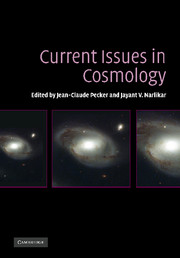Book contents
- Frontmatter
- Contents
- List of contributors
- Preface
- Part I Observational facts relating to discrete sources
- Part II Observational facts relating to background radiation
- Part III Standard cosmology
- Part IV Large-scale structure
- Part V Alternative cosmologies
- 11 The quasi-steady-state cosmology
- 12 Evidence for iron whiskers in the Universe
- 13 Alternatives to dark matter: MOND + Mach
- 14 Anthropic principle in cosmology
- Part VI Evidence for anomalous redshifts
- Part VII Panel discussion
- Index
11 - The quasi-steady-state cosmology
Published online by Cambridge University Press: 15 December 2009
- Frontmatter
- Contents
- List of contributors
- Preface
- Part I Observational facts relating to discrete sources
- Part II Observational facts relating to background radiation
- Part III Standard cosmology
- Part IV Large-scale structure
- Part V Alternative cosmologies
- 11 The quasi-steady-state cosmology
- 12 Evidence for iron whiskers in the Universe
- 13 Alternatives to dark matter: MOND + Mach
- 14 Anthropic principle in cosmology
- Part VI Evidence for anomalous redshifts
- Part VII Panel discussion
- Index
Summary
Abstract
Reasons are given as to why the standard cosmology does not give an entirely satisfactory description of the Universe and why one needs to look for alternative cosmology. An alternative cosmology is presented in which matter creation takes place in mini-creation events at regular intervals and in response the Universe oscillates on a short-term period of ∼50 Gyr while it also has a steady (exponential) long-term expansion at a characteristic time scale of ∼1000 Gyr. The explanation of the major observed features of the Universe in terms of this cosmology is given and new observations distinguishing it from standard cosmology are proposed.
Introduction
Any proposal to describe the Universe in terms different from the so-called standard cosmology is met with the criticism that, “If the standard model is working so well and now it is possible to quantify that model with great precision, why look for an alternative?.” Before describing the quasi-steady-state cosmology (QSSC in brief) I will therefore spend some time in pointing out the weaknesses of standard cosmology, weaknesses that rob it of many of its merits as a scientific theory. First let me talk of the three claimed successes of standard cosmology.
The big-bang cosmology began with the advantage that the models predicting expansion of the Universe by Friedmann (1922, 1924) and Lemaitre (1927) came before the discovery of the phenomenon of recession of galaxies and Hubble's law (1929). Thus one can say that as a scientific theory the big-bang cosmology made a prediction (namely, that the Universe is expanding) that was successfully verified.
- Type
- Chapter
- Information
- Current Issues in Cosmology , pp. 139 - 151Publisher: Cambridge University PressPrint publication year: 2006
- 2
- Cited by



